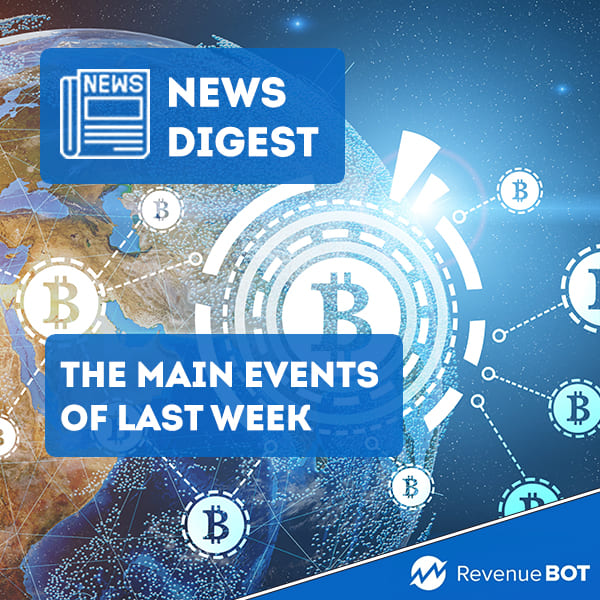
Friday, June 23rd. As the week comes to an end we can focus on the highlights of the crypto industry over the past few days.
Aave rejects to freeze Curve tokens
The Aave community voted unanimously against the Gauntlet team’s proposal to suspend loan collateral in CRV (Curve DAO tokens) under version 2 of the protocol.
Earlier, the DeFi-risk management project in question suggested freezing the CRV and reducing the loan-to-value ratio to zero.
Gauntlet’s attention was drawn to a ~$67.7 million loan in stablecoins backed by collateral in CRV. Analytics platform mark this user’s wallet as associated with Curve Finance founder Michael Egorov.
On June 10, the address deposited an additional 38 million tokens on Aave V2. The collateral volume reached 290 million CRV (~$185 million) which is about 34% of the market offer of the asset.
According to experts, the freeze could prompt Egorov to reduce the loan amount or diversify the collateral “to prevent Aave from accruing bad debt due to the declining liquidity of these tokens on exchanges.”
Moreover, the halt of the coins made it easier to transfer a loan to the third version of Aave.
According to DeBank, Egorov’s so-called “health factor” position is 1.69 as of this writing. This reflects the absence of possible risks – liquidation occurs at the value of 1.
As you may remember, back in May, Aave launched a Temperature Check of the proposal to integrate Coinbase’s Layer 2 Base solution.
As of April, the Aave community supported the deployment of the protocol on the zkSync Era network.
Fed may need more aggressive interest rate hikes
The Federal Reserve is likely to raise interest rates in the coming months. However, they intend to do it at a slower pace than before, said Jerome Powell, the head of the agency, according to The Wall Street Journal.
For the first time since March 2022, on June 14, the Central Bank maintained the range of its key rate at 5-5.25% per annum.
“Given how far we’ve come, it may make sense to move rates higher but to do so at a more moderate pace,” Powell said to the House Financial Services Committee.
The head of the Fed drew comparisons of recent decisions to a driver who, after exiting the highway, drives at a slower speed in order not to miss his final destination.
This year, inflation and economic activity moderated not as much as many officials had expected, the publication pointed out. This has heightened uncertainty as to how much the Fed can tighten monetary policy.
Officials see the risk that previous rate hikes, coupled with recent stresses in the banking sector, will lead to a sharper-than-expected slowdown in GDP growth, the WSJ added. They are seeking to strike a balance between this and the risk that the economy will prove more resilient than anticipated and inflation will remain too high, requiring additional tightening.
Cosmos-based Neutron gains $10M
Neutron, a blockchain project in the Cosmos ecosystem, has closed a $10 million seed funding round led by Binance Labs and CoinFund.
Among other investors are Delphi Ventures, LongHash, Semantic Ventures, and Nomad.
Neutron offers developers a cost-effective and secure environment for building smart contracts and decentralized applications (DApps). The project’s infrastructure and tools are built on Cosmos SDK and CosmWasm technologies, ensuring compatibility with 51 upchains in the ecosystem.
“Neutron was designed to solve the three main hurdles faced by smart-contract developers in Cosmos: lack of security, lack of credible neutrality and lack of access to cross-chain infrastructure,” said Neutron founding contributor Avril Dutheil in an emailed statement to CoinDesk.
The project launched in May and was the first Cosmos blockchain to run using Replicated Security feature. This functionality is a way for so-called “consumer chains” to connect to Cosmos Hub validators to run applications securely.
As the team puts it, proceeds raised will be used to support the expansion of the Neutron ecosystem and encourage the development of new dApps.
To recap, the blockchain interoperability-focused Connext generated $7.5 million at an estimate of $250 million.
Crypto whales withdraw $150M in ETH from Binance and Kraken
Over the past week, Lookonchain analysts detected three large withdrawals from Binance and Kraken exchanges totaling 86,520 ETH (~$150 million).
The outflow of whales from centralized trading platforms is likely due to the traders’ decision to store crypto on their own amid regulatory challenges in the U.S.
On June 5, the U.S. Securities and Exchange Commission (SEC) sued Binance and its CEO Changpeng Zhao. The agency brought 13 charges, including the sale of unregistered securities.
In return, the company issued a statement stating its readiness to “vigorously defend” itself. Afterwards, Binance.US announced the suspension of dollar deposits and prompted customers to withdraw their fiat funds by June 13.
Similar charges were brought by the SEC on June 6 against Coinbase. The company refused to change its business model because of the Commission’s lawsuit.
It should be noted that Glassnode analysts reported that the Bitcoin balance of the platform has shrunk by 10,500 BTC since the accusations against Binance were made.
